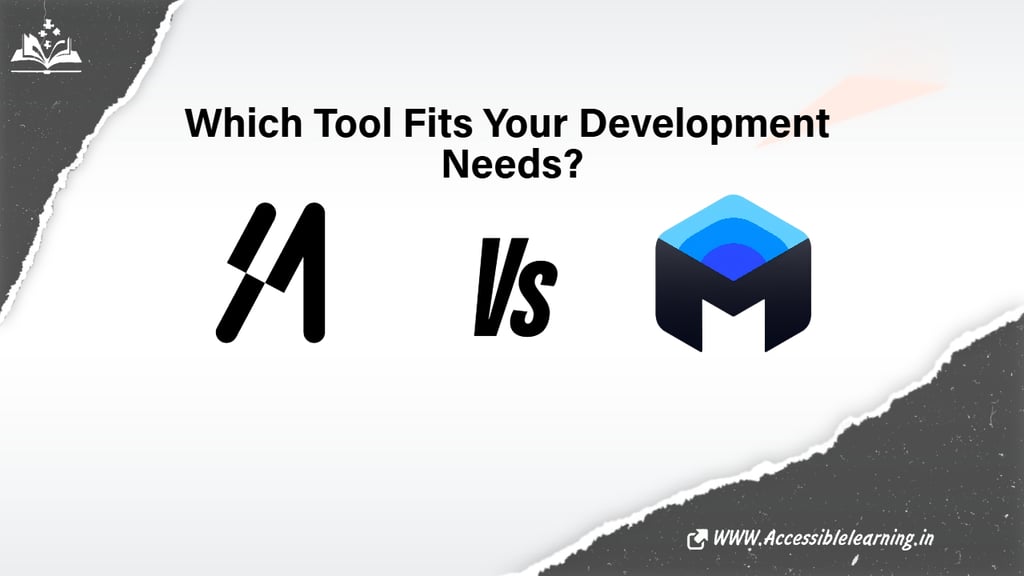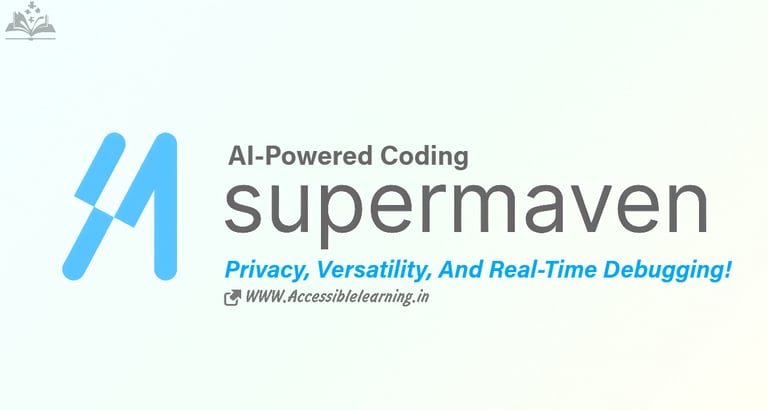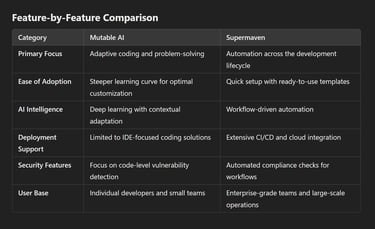
Which is Better: Mutable AI or Supermaven? A Comprehensive Analysis?
Explore a comprehensive comparison of Mutable AI and Supermaven, two cutting-edge tools revolutionizing software development. This in-depth guide covers features, use cases, integration capabilities, performance metrics, and expert recommendations to help you choose the right solution for your projects.
AI ASSISTANTAI/FUTUREPROGRAMMINGEDUCATION/KNOWLEDGE
Sachin K Chaurasiya
12/7/20246 min read


As artificial intelligence and automation redefine the boundaries of software development, tools like Mutable AI and Supermaven are transforming how developers code, test, and deploy. Each platform offers distinct advantages, tailored to different stages of the development lifecycle. This article provides an expanded comparison, diving deeper into the features, benefits, use cases, and potential drawbacks of both Mutable AI and Supermaven.
What is Mutable AI?
Mutable AI is a cutting-edge development tool designed to simplify complex coding processes. Built with a focus on adaptability and intelligence, it empowers developers to code more efficiently while maintaining high-quality standards.
Advanced Features of Mutable AI!
Natural Language Coding
Allows developers to describe functionalities in plain English.
Automatically converts these descriptions into syntactically correct code.
Intelligent Error Handling
Detects errors in real time and provides actionable fixes.
Offers suggestions tailored to the project’s specific context.
Custom Model Training
Developers can train the AI on proprietary codebases, making it contextually smarter over time.
Security-Focused Features
Identifies vulnerabilities in code and suggests security improvements.
Integrates with third-party security tools for compliance checks.
Use Cases for Mutable AI
Optimizing Legacy Codebases
Ideal for projects requiring modernization without rewriting code from scratch.
Accelerating Debugging
Helps developers pinpoint issues faster with guided debugging suggestions.
Supporting New Developers
Acts as an intelligent tutor for junior developers by providing explanations for complex code.
Pricing Models
Offers tiered pricing based on features such as natural language processing, collaboration tools, and enterprise support.
Free tier available for individual developers with limited functionality.
Enterprise plans include advanced features like custom model training.
Strengths
Personalized AI that learns from your coding habits.
Strong focus on clean, efficient, and maintainable code.
Challenges
Lacks extensive deployment features.
Geared more toward individual developers or small teams.
AI-Powered Learning for Beginners
Acts as a mentor for junior developers by explaining code logic and suggesting improvements.
It helps self-taught programmers learn faster through its contextual hints.
Real-Time Refactoring for Enterprises
Large organizations can use Mutable AI to refactor legacy code incrementally without disrupting operations.


What is Supermaven?
Supermaven is a robust automation platform aimed at streamlining the entire development lifecycle. It’s designed for teams that value speed, consistency, and reliability in their workflows, from coding to deployment.
Advanced Features of Supermaven
Workflow Customization
Developers can create custom pipelines tailored to their unique processes.
Offers drag-and-drop functionality for ease of setup.
AI-Powered Testing
Automatically generates test cases based on code analysis.
Provides predictive analytics to identify high-risk areas in applications.
Version Control Integration
Works seamlessly with Git, GitHub, GitLab, and other version control systems.
Automates code reviews to maintain quality standards.
Scalability Tools
Optimized for scaling applications in multi-cloud and hybrid environments.
Includes features for load testing and resource allocation.
Use Cases for Supermaven
Enterprise Development Teams
Suitable for large teams managing complex applications with multiple contributors.
Continuous Integration and Continuous Deployment (CI/CD)
Reduces manual intervention, ensuring fast and error-free deployments.
Cross-Platform Development
Supports diverse environments, making it perfect for organizations with varied tech stacks.
Pricing Models
Pricing is usage-based, with options for startups and enterprise customers.
Free trial available for small teams.
Enterprise plans include advanced CI/CD tools, multi-cloud support, and dedicated customer service.
Key Considerations Before Choosing
Strengths
Comprehensive support for automated testing and deployment.
Ideal for teams with a heavy focus on DevOps and CI/CD workflows.
Challenges
Code suggestion capabilities are less advanced than Mutable AI.
May be overkill for small projects or individual developers.
Multi-Cloud Management
Supports deployment across multiple cloud providers, ensuring redundancy and reliability.
Simplifies migration between cloud services.
Compliance Automation
Automatically enforces regulatory and security compliance during code builds and deployments.
Generates audit logs for governance.


Advanced Code Understanding
Mutable AI
Utilizes cutting-edge machine learning to understand the context of your codebase.
Can analyze intricate dependencies, making it ideal for large and complex applications.
Offers dynamic code scaffolding, generating boilerplate code based on minimal input.
Supermaven
Excels in modular code management, helping teams build reusable components.
Incorporates a repository of code templates that adhere to industry best practices.
AI-Powered Collaboration
Mutable AI
Features real-time collaboration within IDEs, providing coding suggestions to multiple users simultaneously.
Supports asynchronous commenting, enabling team discussions directly within the codebase.
Supermaven
Tailored for DevOps collaboration, ensuring smooth handoffs between development, testing, and deployment teams.
Offers pipeline visualization tools, enabling teams to monitor workflow stages and identify bottlenecks.
Scalability and Performance
Mutable AI
Focuses on scaling through intelligent optimization.
Identifies areas for parallelization in code, ensuring better resource utilization.
Supermaven
Designed for enterprise-level scalability, managing hundreds of pipelines simultaneously.
Includes auto-scaling deployment features for cloud environments like AWS, Azure, and Google Cloud.
Customization Options
Mutable AI
Developers can create custom models tailored to specific project needs.
Allows API integrations for extending its core functionalities.
Supermaven
Provides deep customization of CI/CD pipelines through YAML configurations.
Includes a plugin ecosystem, enabling users to add features like custom metrics tracking and third-party service integration.
Integration Capabilities
Mutable AI
Compatible with popular IDEs like Visual Studio Code, IntelliJ IDEA, and PyCharm.
Supports APIs for integration with custom tools, enhancing its adaptability in diverse environments.
Integrates with GitHub Copilot, offering an added layer of intelligence for developers.
Supermaven
Works seamlessly with Jenkins, GitLab CI/CD, and other DevOps tools.
Integrates with Kubernetes for container orchestration, making it a go-to for cloud-native applications.
Offers connectors for JIRA, Trello, and Slack, ensuring synchronized communication across teams.
Performance Metrics
Mutable AI
Improved coding efficiency by up to 40% through automated suggestions and refactoring.
Reduces debugging time by 50% with real-time error detection and contextual fixes.
Supermaven
Cuts deployment times by 60% with automated pipelines.
Ensures 99.9% reliability in CI/CD processes through built-in redundancies and monitoring.

User Experience (UX)
Mutable AI
Ease of Use
Designed with simplicity in mind, especially for individual developers.
Offers a minimalistic UI for direct integration into the IDE.
Learning Curve
May require time to customize and fully leverage its capabilities, especially for larger teams.
Supermaven
Ease of Use
Comprehensive dashboards provide a clear overview of pipelines and project statuses.
Built for teams with structured workflows, offering step-by-step configuration wizards.
Learning Curve
lightly steeper for small teams unfamiliar with DevOps practices but intuitive for larger enterprises.
Ideal Scenarios for Deployment
When to Choose Mutable AI
Solo developers or small teams aiming to improve code quality and reduce debugging efforts.
Projects requiring significant optimization and adaptability.
Organizations looking for an AI assistant to enhance developer productivity.
When to Choose Supermaven
Enterprise teams manage large-scale, multi-platform projects.
Development environments with a strong emphasis on automation and streamlined workflows.
Teams focusing on rapid deployment, testing, and scaling in cloud environments.
Industry Adoption
Mutable AI
Startups: Startups in need of smart coding assistants for MVP development.
Tech Giants: Companies like Microsoft and Amazon have shown interest in tools with similar features for internal development.
Supermaven
Enterprises: Financial institutions and healthcare companies rely on it for secure, compliant deployments.
Cloud Providers: Partners with cloud giants for seamless CI/CD integration.
The Future of Mutable AI and Supermaven?
As technology progresses, Mutable AI and Supermaven are likely to expand their capabilities.
Mutable AI: Incorporating more natural language processing (NLP) features to allow non-programmers to participate in coding workflows.
Supermaven: Further integration with AI-driven observability tools to ensure zero-downtime deployments.
Real-World Scenarios
Scenario 1: Small Startup Building a SaaS Application
Choose Mutable AI: The startup's team of developers can leverage Mutable AI for coding efficiency, real-time debugging, and improving code quality.
Scenario 2: Large Enterprise with Complex Workflows
Choose Supermaven: For an enterprise managing dozens of projects, Supermaven automates the entire development pipeline, ensuring scalability and consistency.
Scenario 3: Freelance Developer Working on Diverse Projects
Choose Mutable AI: A freelancer working across languages and frameworks can benefit from Mutable AI’s language-agnostic and adaptive features.


Future Outlook
As Mutable AI and Supermaven continue to evolve, the line between coding assistance and automation is likely to blur further. Developers may eventually see a unified platform offering the intelligence of Mutable AI combined with the lifecycle automation of Supermaven.
Predictions for Mutable AI
Greater emphasis on natural language interfaces.
Expanded integrations with cloud and CI/CD tools.
Predictions for Supermaven
Enhanced AI capabilities for intelligent coding suggestions.
Integration of real-time analytics to optimize deployment strategies.
Both Mutable AI and Supermaven are indispensable tools, but they serve different purposes. Mutable AI is perfect for developers seeking an AI companion to enhance coding productivity and quality, while Supermaven is ideal for teams aiming to automate and scale their development workflows. Your choice should depend on the size of your team, the complexity of your projects, and your focus areas, whether it's code quality or lifecycle efficiency.
By understanding the strengths and use cases of each platform, you can unlock new levels of productivity and innovation in your development journey.
Subscribe To Our Newsletter
All © Copyright reserved by Accessible-Learning Hub
| Terms & Conditions
Knowledge is power. Learn with Us. 📚


